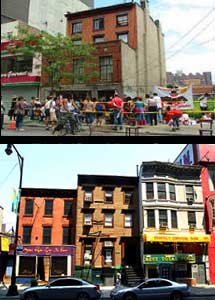The city’s memorial to Brooklyn’s Underground Railroad history will sit atop an underground parking lot that will be built where some of the very Abolitionist history being commemorated is said to have actually happened.The article continues:
City officials have denied that the Duffield houses were directly linked to the Underground Railroad, and the RFP continues that position: “A number of homes and churches in Downtown Brooklyn and the surrounding area have connections with the Underground Railroad [including] Plymouth Church (now Plymouth Church of the Pilgrims) in Brooklyn Heights; Bridge Street A.W.M.E. Church (now Polytechnic University student center in MetroTech); Lafayette Avenue Presbyterian Church in Fort Greene; and the Siloam Presbyterian Church, and Concord Baptist Church.”Part of the irony is that there already are ongoing programs and activities at 227 and 233 Duffield Street. Lewis Greenstein, owner of 233 Duffield, opens his home every Sunday afternoon for tours of the evidence of Underground Railroad activity in his basement.
The winning bidder must not only design a great monument, but also “provide an interactive, public gathering venue where individuals and groups of all ages can learn about the Abolitionist Movement and the Underground Railroad in Brooklyn.”
In addition, the “Abolitionism Commemoration” must include “an ongoing program or series of activities” and “demonstrate program sustainability using allocated funds for at least the next three fiscal years and … with other sources of funding beyond [that].”
The Brooklyn Paper also points out the double standards of the EDC. The agency denies that there is sufficient proof of escaped slaves in the basements of Duffield Street to save them, yet they mention Plymouth Church. While Plymouth Church is a famous Abolitionist church, there is no more physical evidence of escaped slaves hiding there than at Duffield Street.
